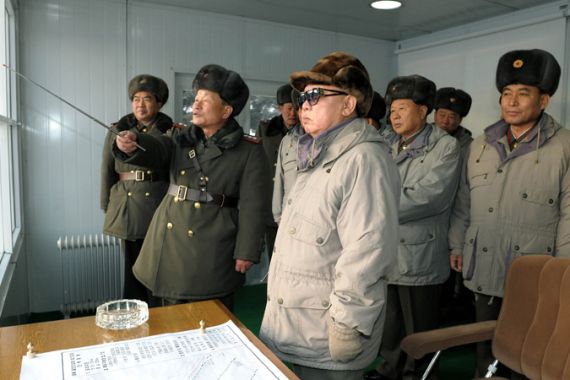S Koreans protest at tense border
Activists from South Korea agitate at the tense border with the north, after a stern New Year’s message from Pyongyang.

 |
| The Korean border remains tense, as S Korean soldiers have carried out a series of drills during the past month [AFP] |
South Korean activists have rallied against North Korea near the heavily fortified border, burning placards with the images of North Korean leaders.
The activists criticised leader Kim Jong-il over North Korea’s artillery attack on the South in November during a rally at the South Korean border town of Imjingak on Sunday.
Keep reading
list of 4 itemsAfter the Hurricane
World’s coral reefs face global bleaching crisis
Why is Germany maintaining economic ties with China?
Thwarted by strong winds, the activists also unsuccessfully tried to launch thousands of propaganda leaflets in balloons toward North Korea.
The activists also burned placards with the images of a North Korean national flag and the photos of Kim and his son and heir-apparent Kim Jong-un before flying the balloons.
Korean tensions
For its part, North Korea welcomed the new year on Saturday with a push for better ties with rival South Korea, warning that war “will bring nothing but a nuclear holocaust”.
Despite calls in its annual New Year’s message for a Korean peninsula free of nuclear weapons, the North, which has conducted two nuclear tests since 2006, also said its military was ready for “prompt, merciless and annihilatory action” against its enemies.
The North’s holiday message comes in the wake of its November 23 artillery attack on a front-line South Korean island near the countries’ disputed western sea border.
That barrage, which followed an alleged North Korean torpedoing of a South Korean warship in March, sent tensions between the Koreas soaring and fuelled fears of war during the last weeks of 2010.
In a joint editorial in three newspapers, carried in the official Korean Central News Agency, the North said confrontation between the two Koreas should be quickly defused and called for a push to improve Korean relations.
South Korea’s Unification Ministry, which handles relations with North Korea, said its officials were in the process of analysing the North’s message.
Four South Koreans, including two civilians, were killed in the November shelling of Yeonpyeong Island, which North Korea carried out after warning Seoul against conducting live-fire drills there.
The attack was the first on a civilian area since the 1950-53 Korean War.
Possible escalation
The South Korean government has strengthened security and deployed additional troops and weaponry to Yeonpyeong, which lies just 11km from North Korean shores.
North Korea does not recognise the maritime border drawn by the UN in 1953, and it claims the waters around the island as its own.
The Korean peninsula remains technically in a state of war because the conflict ended in a truce, not a peace treaty.
Six-nation talks on ending North Korea’s nuclear weapons programme have been stalled for nearly two years.
Washington and Seoul, however, are insisting that the North make progress on past disarmament commitments before negotiations can resume.
North Korea also stoked new worries about its nuclear programme in November when it revealed a uranium enrichment facility – which could give it a second way to make atomic bombs.
North Korea is believed to have enough weaponised plutonium for at least a half-dozen atomic bombs.